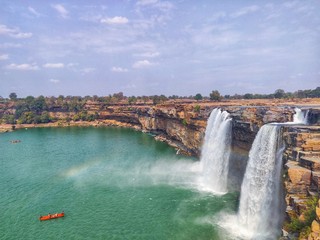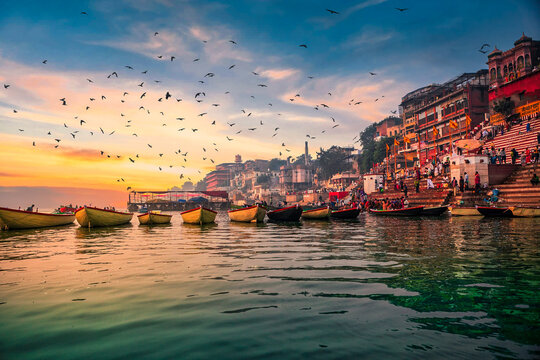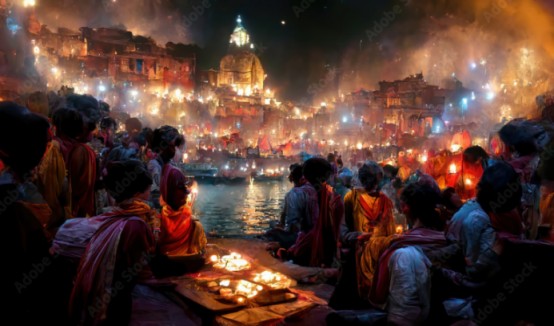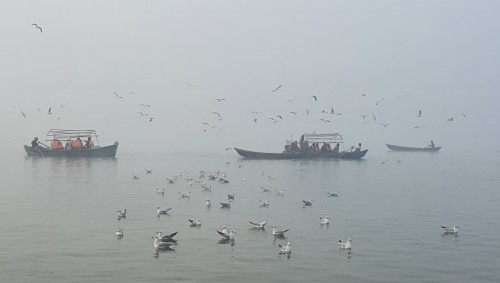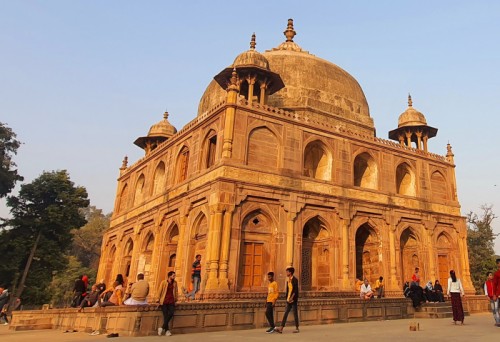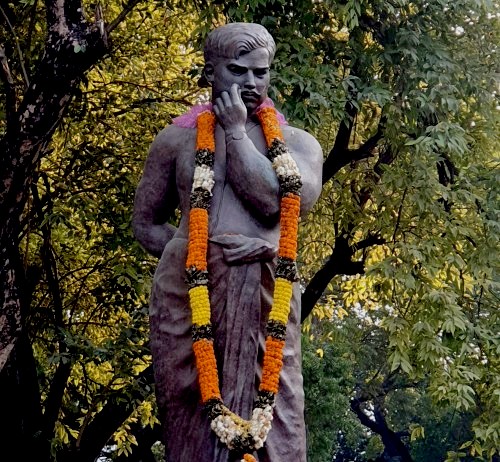Chitrakoot is a pilgrimage centre and a nagar panchayat in the Satna district in the state of Madhya Pradesh, India.
Connected to the Indian epic Ramayana, it is a place of religious, cultural, historical and archaeological importance,
situated in the Baghelkhand region. It borders the Chitrakoot district in Uttar Pradesh, whose headquarters Chitrakoot
Dham is located nearby. The city lies in the historical Chitrakoot region, which is divided between the present-day Indian
states of Uttar Pradesh and Madhya Pradesh. It is known for a number of temples and sites mentioned in Hindu scriptures.
It attracts pilgrims throughout the year on occasions such as Amavasya, Somwati Amavasya, Deepawali, Sharad-Poornima,
Makar Sankranti, Rama Navami and for Free Eye Care Medical Camps.
Noted 'Ayurvedic' and 'Yoga' centres like 'Arogyadham' are located in Chitrakoot.
Source: https://en.wikipedia.org/wiki/Chitrakoot,_Madhya_Pradesh
Chitrakoot
Varanasi
Varanasi also Banaras is a metropolis city on the Ganges river in the Bhojpur-Purvanchal region of Uttar Pradesh, India. considered to be a holy city; that has a central place in the traditions of pilgrimage, death, and mourning in the Hindu world. Located in the middle-Ganges valley in the southeastern part of the state of Uttar Pradesh, Varanasi lies on the left bank of the river. Varanasi is one of the world's oldest continually inhabited cities. Kashi, its ancient name, was associated with a kingdom of the same name of 2,500 years ago. Source: https://en.wikipedia.org/wiki/Varanasi
Ayodhya
Ayodhya is a city situated on the banks of the Saryu river in the Indian state of Uttar Pradesh. Ayodhya was historically known as Saketa.
The early Buddhist and Jain canonical texts mention that the religious leaders Gautama Buddha and Mahavira visited and lived in the city.
The legendary city of Ayodhya, popularly identified as the present-day Ayodhya, is the birthplace of the Hindu deity Rama of Kosala and
setting of the great epic Ramayana and its many versions. Owing to the belief as the birthplace of Rama, Ayodhya has been regarded as the
first of the seven most important pilgrimage sites for Hindus.
Source: https://en.wikipedia.org/wiki/Ayodhya
Triveni Sangam
Triveni Sangam is the confluence of the Ganges (Ganga), the Yamuna, and the mythical Saraswati River.
Triveni Sangam is located at Prayag - the area of Prayagraj neighbouring the confluence; for this reason,
the confluence is also sometimes referred to as Prayag. At Triveni Sangam, the Ganges and the Yamuna can be
identified by their different colours - the water of the Ganges is clear while that of the Yamuna is greenish
in colour. The third river, the mythical Saraswati, is called invisible. The auspiciousness of the confluence of
two rivers is referred to in the Rigveda, which says, "Those who bathe at the place where the two rivers, white and dark,
flow together, rise up to heaven." A place of religious importance and one of the sites for the historic Kumbh Mela held
every 12 years, over the years it has also been the site of the immersion of ashes of several national leaders, including Mahatma Gandhi in 1949.
Source: https://en.wikipedia.org/wiki/Triveni_Sangam
Khusro Bagh
Khusro Bagh is a large walled garden and burial complex located in muhalla Khuldabad, close to the Allahabad Junction railway station, in Prayagraj, India.
It is roughly 6 km from the Akbar fort built-in (r. 1556-1605).
It is situated over forty acres and shaped like a quadrangle.
It includes the tombs of Shah Begum (born Manbhawati Bai) (d. 1604), Jahangir's Rajput wife, and the daughter of Raja Bhagwant Das and Khusrau Mirza's (d. 1622) mother;
Khusrau Mirza, Jahangir's eldest son and briefly heir apparent to the Mughal throne; and Nithar Begum (born Sultan-un-Nissa) (d. 1646), Khusrau Mirza's sister and Jahangir's daughter.
It is listed as an Indian Site of National Importance.
Source: https://en.wikipedia.org/wiki/Khusro_Bagh
Allahabad Fort
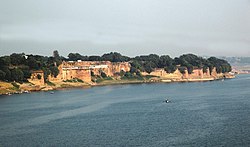
Allahabad Fort is a fort built by the Mughal emperor Akbar at Allahabad, Uttar Pradesh, India in 1583.
A stone inscription inside fort describe 1583 as a foundation year but this stone inscription related to Ashok
which was early period situated in kaushambi and taken from there to allahabad fort. The fort stands on the banks of
the Yamuna near its confluence with the river Ganges. It is recognised by the Archaeological Survey of India as a monument of national importance.
Source: https://en.wikipedia.org/wiki/Allahabad_Fort
Chandrashekhar Azad Park
Chandrashekhar Azad Park (also known by its former name Alfred Park, and Company Bagh during the Company Raj)
is a public park in Prayagraj, Uttar Pradesh, India. Built in 1870 to mark Prince Alfred's visit to the city, with an
area of 133 acres, it is the biggest park in Prayagraj. It was renamed by the Uttar Pradesh Government after
revolutionary Chandra Shekhar Azad, who sacrificed his life here during the Indian independence movement in 1931.
Source: https://en.wikipedia.org/wiki/Chandrashekhar_Azad_Park
Anand Bhavan
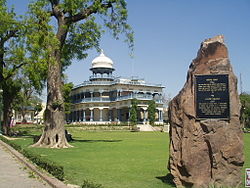
The Anand Bhavan is a historic house museum in Prayagraj, India, focusing on the Nehru family.
It was bought by Indian political leader Motilal Nehru in the 1930s to serve as the residence of the Nehru family
when the original mansion Swaraj Bhavan (previously called Anand Bhavan) was transformed into the local headquarters of the Indian National Congress.
Jawahar Planetarium is situated here, which has been striving to inculcate scientific temper among masses through its sky shows on astronomy and science.
The residence was donated to Indian government in 1970 by the then Prime Minister of India Indira Gandhi,
the granddaughter of Motilal Nehru and daughter of Jawaharlal Nehru.
Source: https://en.wikipedia.org/wiki/Anand_Bhavan
Jawahar Planetarium
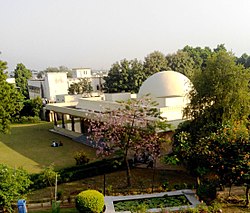
The Jawahar Planetarium is located in the city of Prayagraj in Uttar Pradesh, India.
It was built in 1979 and is situated beside Anand Bhavan the former residence of the Nehru-Gandhi
family and now a museum. It is managed by the 'Jawaharlal Nehru Memorial Fund' (established 1964),
which has its headquarters at Teen Murti House, New Delhi. Each year, the prestigious 'Jawaharlal
Nehru Memorial Lecture' is also held at the planetarium, organised under the auspices of Jawaharlal
Nehru Memorial Fund on the birth anniversary of India's first prime minister, 14 November.
Source: https://en.wikipedia.org/wiki/Jawahar_Planetarium
Allahabad Museum
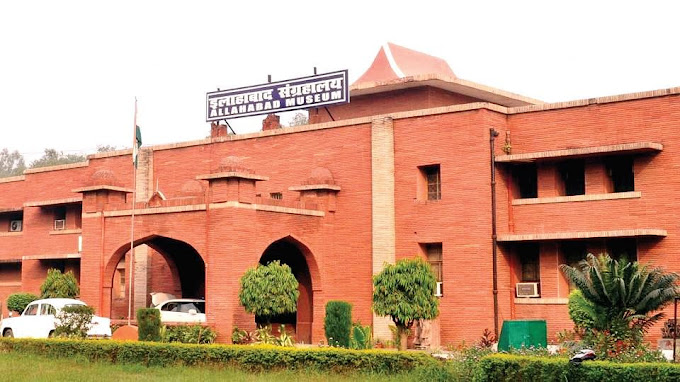
The Allahabad Museum is a national-level museum in Prayagraj, Uttar Pradesh. Established in 1931, it is known for its rich collection and unique
objects of art, and is funded by Ministry of Culture. Moreover, it is a premier research centre for archaeologists, historians and academicians and
carries out extensive research activities and publications in archaeology, art and literature. Its rock art gallery has the largest collection of
prehistoric paintings displayed in India dating from 14,000 B.C to 2000 B.C. The museum, using solar power system, has become the first museum in
the country to become self-reliant in power generation. The Allahabad Museum is centrally located in the Civil Lines area of the city in a lush green
garden at Chandrashekhar Azad Park, popularly known as Company Bagh. It is about 3 km away from the Allahabad railway junction and almost equidistant
from three different Railway Stations such as Prayag, Rambagh and Allahabad junction and about 12 km away from Bamrauli Airport.
Source: https://en.wikipedia.org/wiki/Allahabad_Museum
All Saints Cathedral
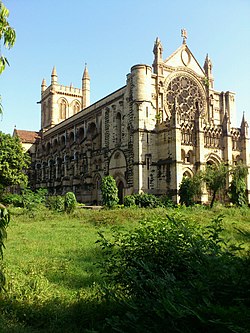
All Saints' Cathedral, also known as Patthar Girja (Church of Stones), is an Anglican cathedral located in Prayagraj, India.
Modelled after 13th-century Gothic style churches, it is among the Gothic Revival buildings built by the British during their rule in India.
British architect Sir William Emerson, who also designed the Victoria Memorial, Kolkata, designed the cathedral in 1871.
It was consecrated in 1887 and was completed four years later. The church celebrates its anniversary on All Saints' Day
(1 November) and has been part of the Church of North India since 1970. The cathedral is at the centre of a large open space at
the crossing of two of the principal roads of Allahabad, MG Marg and SN Marg.
Source: https://en.wikipedia.org/wiki/All_Saints_Cathedral,_Allahabad
ISKCON Temple, Prayagraj
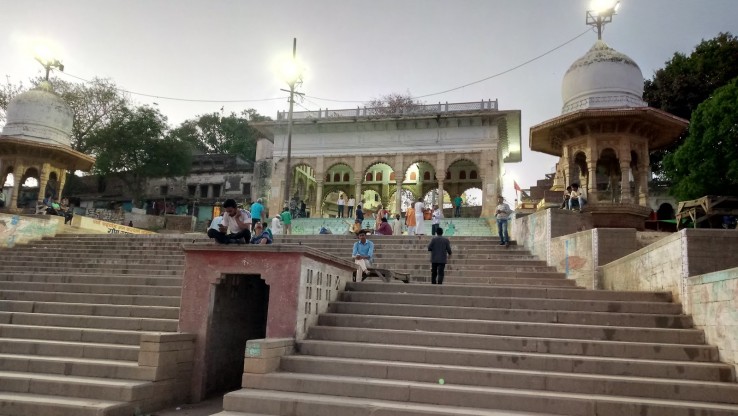
The International Society for Krishna Consciousness (ISKCON), known colloquially as the Hare Krishna movement
or Hare Krishnas, is a Gaudiya Vaishnava Hindu religious organization. ISKCON was founded in 1966 in New York
City by A. C. Bhaktivedanta Swami Prabhupada. Its core beliefs are based on Hindu scriptures, particularly the Bhagavad Gita
and the Bhagavata Purana. ISKCON is "the largest and, arguably, most important branch" of Gaudiya Vaishnava tradition,
which has had adherents in India since the early 16th century and American and European devotees since the early 1900s.
ISKCON was formed to spread the practice of Bhakti yoga, the practice of love of God in which those involved (bhaktas)
dedicate their thoughts and actions towards pleasing Krishna, whom they consider the Supreme Lord. Its most rapid expansion
in membership have been within India and (after the collapse of the Soviet Union) in Russia and other formerly Soviet-aligned states of Eastern Europe.
Source: https://en.wikipedia.org/wiki/International_Society_for_Krishna_Consciousness
